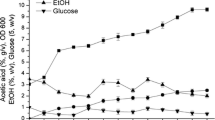Abstract
Acetobacter pasteurianus plays an important role in the process of traditional vinegar production and is also essential for the fermentation of Zhenjiang aromatic vinegar. In this study, we utilized the proteomic approach to analyze the proteomic profile of A. pasteurianus HSZ3-21, and 258 proteins were successfully identified by MALDI–TOF-MS and database search. The hydropathy and GO analyse combined with COG results of the identified proteins revealed the molecular biological characteristics of A. pasteurianus proteins, that is, most proteins of A. pasteurianus were related to metabolic process, binding, catalytic or cellular response. Meanwhile, our results also showed that some proteins of A. pasteurianus may be responsible for acetic acid tolerance, thermotolerance, and stress response. Therefore, the identification of 258 proteins not only deciphers protein composition and functional classification of A. pasteurianus, but also provides useful information for improving quality of Zhenjiang aromatic vinegar.




Similar content being viewed by others
References
Andres-Barrao C, Saad MM, Chappuis ML et al (2012) Proteome analysis of Acetobacter pasteurianus during acetic acid fermentation. J Proteomics 75(6):1701–1717
Arguelles JC (2000) Physiological roles of trehalose in bacteria and yeasts: a comparative analysis. Arch Microbiol 174(4):217–224
Ausubel FM, Brendt R, Kingston RE et al (1994) Current protocols in molecular biology. Wiley, New York
Bradford MM (1976) A rapid and sensitive method for the quantitation of microgram quantities of protein utilizing the principle of protein-dye binding. Anal Biochem 72(1):248–254
Guillot A, Gitton C, Anglade P et al (2003) Proteomic analysis of Lactococcus lactis, a lactic acid bacterium. Proteomics 3(3):337–354
Gullo M, Caggia C, De Vero L et al (2006) Characterization of acetic acid bacteria in “traditional balsamic vinegar″. Int J Food Microbiol 106(2):209–212
Illeghems K, De Vuyst L, Weckx S (2013) Complete genome sequence and comparative analysis of Acetobacter pasteurianus 386B, a strain well-adapted to the cocoa bean fermentation ecosystem. BMC Genom 14:526
Kyte J, Doolittle RF (1982) A simple method for displaying the hydropathic character of a protein. J Mol Biol 157(1):105–132
Lasko DR, Schwerdel C, Bailey JE et al (1997) Acetate-specific stress response in acetate-resistant bacteria: an analysis of protein patterns. Biotechnol Progr 13(5):519–523
Matsutani M, Hirakawa H, Saichana N et al (2012) Genome-wide phylogenetic analysis of differences in thermotolerance among closely related Acetobacter pasteurianus strains. Microbiology 158(1):229–239
Moonmangmee S, Toyama H, Adachi O et al (2002) Purification and characterization of a novel polysaccharide involved in the pellicle produced by a thermotolerant Acetobacter strain. Biosci Biotechnol Biochem 66(4):777–783
Murata M, Fujimoto H, Nishimura K et al (2011) Molecular strategy for survival at a critical high temperature in Eschierichia coli. PLoS One 6(6):e20063
Nakano S, Fukaya M, Horinouchi S (2004) Enhanced expression of aconitase raises acetic acid resistance in Acetobacter aceti. FEMS Microbiol Lett 235(2):315–322
Nakano S, Fukaya M, Horinouchi S (2006) Putative ABC transporter responsible for acetic acid resistance in Acetobacter aceti. Appl Environ Microbiol 72(1):497–505
Okamoto-Kainuma A, Yan W, Fukaya M et al (2004) Cloning and characterization of the dnaKJ operon in Acetobacter aceti. J Biosci Bioeng 97(5):339–342
Okamoto-Kainuma A, Yan W, Kadono S et al (2002) Cloning and characterization of groESL operon in Acetobacter aceti. J Biosci Bioeng 94(2):140–147
Qi Z, Wang W, Yang H et al (2014) Mutation of Acetobacter pasteurianus by UV irradiation under acidic stress for high-acidity vinegar fermentation. Int J Food Sci Tech 49(2):468–476
Steiner P, Sauer U (2001) Proteins induced during adaptation of Acetobacter aceti to high acetate concentrations. Appl Environ Microbiol 67(12):5474–5481
Wu J, Gullo M, Chen F et al (2010) Diversity of Acetobacter pasteurianus strains isolated from solid-state fermentation of cereal vinegars. Curr Microbiol 60(4):280–286
Acknowledgments
This work was supported by the Postdoctoral Science Foundation of China (2013M531289), Universities Natural Science Research Project of Jiangsu Province (13KJB180006), and Senior talent funds of Jiangsu University (05JDG030).
Author information
Authors and Affiliations
Corresponding author
Electronic supplementary material
Below is the link to the electronic supplementary material.
Rights and permissions
About this article
Cite this article
Zhang, Z., Ma, H., Yang, Y. et al. Protein Profile of Acetobacter pasteurianus HSZ3-21. Curr Microbiol 70, 724–729 (2015). https://doi.org/10.1007/s00284-015-0777-y
Received:
Accepted:
Published:
Issue Date:
DOI: https://doi.org/10.1007/s00284-015-0777-y




